Ludwig Otto Friedrich Wilhelm became King Ludwig II of Bavaria in 1864 at the age of 18 after succeeding his Father, Maximilian II.
Best remembered for his eccentric lifestyle and the creation of the most stunning fairytale-like castles and palaces that still exist in Europe today, we also have Ludwig to thank for Wagner’s success.
Disclaimer: This post contains affiliate links. This means that should you click on certain links and then subsequently purchase a product, I will receive a small commission.
Where to Stay in Bavaria
There are many beautiful hotels in Bavaria where you can base yourself and book a rental car so you can explore these incredible King Ludwig castles at your own pace.
AMERON Neuschwanstein Alpsee Resort & Spa: Located right next to Neuschwanstein Castle and Hohenschwangau Castle, the hotel rooms and the spa area offer views of the stunning Alpsee Lake, the mountain range and the famous fairytale-like Neuschwanstein Castle, as well as the castle Hohenschwangau. Book your stay here.
Hotel Klosterhotel Ludwig der Bayer: Located in Ettal, the hotel is next to the famous Ettal monastery and the closest hotel to visit, Linderhof Palace. You can relax at the hotel spa or in front of the cozy fireplace while taking a sip of beer from the monastery’s own brewery. Book your stay here.
Hotel Marina: To be centrally located in the middle of King Ludwig’s castles, stay in this beautiful hotel on the banks of Lake Starnberg. Surrounded by Alpine vistas and parkland, this oasis is a great place to base yourself for a peaceful stay. Take your breakfast on the lawn by the lake, relax in your sunny bedroom or swim in the pool. Book your stay here.
Landgasthof Karner: Close to Chiemsee Lake, and the Herrenchiemsee Palace, is this beautiful hotel at the foot of the Alps between Munich and Salzburg. With opulently decorated rooms, a wellness center, a pool, and a sauna, you can easily explore the surrounding area. If you visit in the winter, the area is perfect for ski enthusiasts. Book your stay here.
How to Get Around
The best way to visit King Ludwig’s Castles in Germany is by car, as some of the castles are in secluded areas of Bavaria.
I recommend booking a car through Discover Cars, where you can compare all rental car agencies’ prices, and you can cancel or modify your booking for free. They also guarantee the best price. Click here for more information and to check the latest prices.
You can also book a tour from Munich to enjoy the beautiful castles Neuschwanstein, Hohenschwangau, and Linderhof Palace. Click here for more information, availability, and the latest prices.
If you want to visit Herrenchiemsee Palace, you can book a tour from Munich as well. Click here for more information and the latest prices.
Alternatively, you can take the train to visit some of the castles. Click here for more information on train tickets.
Born in 1845 at Nymphenburg Castle but spending his childhood at Hohenschwangau Castle, Ludwig was a lonely child, himself and his younger brother receiving little love or attention from their parents, Princess Marie of Prussia and King Maximilian of Bavaria, who also had little love for each other.
It’s little wonder, then, that little Prince Ludwig lived in his imagination, his fondness for fairytales and legends staying with him throughout adulthood.
When King Maximilian, Ludwig’s father, died without warning in 1519, the handsome prince was thrust onto the throne at the age of 18, ill-prepared and inexperienced.
Around this time, Ludwig was captivated, even obsessed, with the operatic works of Wagner, thanks to the composer basing his works on German mythology.
Ludwig summoned Wagner to court soon after he became King, and the collaborative relationship between the two men resulted in Ludwig building concert halls to honor Wagner’s work.
Had the King not taken such an unprecedented interest in Wagner’s work, it is unlikely that he would have gained such success but equally, without Richard Wagner to inspire Ludwig, he may not have dreamed up such fantastical fairytale castles.
Said to have been a kind and visible King in those early years, one who often rode out across his lands, Ludwig II was known to gift huge sums of money to kindly peasants that he came across whilst out riding.
But aged 20, just 2 years after becoming King, Ludwig II experienced a catastrophic defeat that haunted him for the rest of his life.
Neighboring Prussia conquered Bavaria as well as Austria during the ‘German War’ of 1866, which lasted just a matter of weeks, meaning that the once independent nation of Bavaria became an annex of Prussia.
Later, in 1870, Bavaria became part of the new German Empire which saw Bavaria retain a certain degree of autonomy but even with the people remaining sympathetic to the young Kings plight, Ludwig could not recover from the terrible defeat so early on in his reign.
He began to lose himself more and more in his imagination, helped along by Wagner’s fantasy worlds until he neglected his day-to-day- duties as King, eventually becoming entirely nocturnal.
His love of the fantasy world inspired the King to build 3 fairytale-like castles and palaces over the years, along with a more modest mountain retreat.
Using his royal revenues to fund the projects as well as borrowing heavily, he had a debt of 14 million marks to his name by 1885 though this debt did not bankrupt the state of Bavaria as is often presumed.
King Ludwig could not stop his obsession, and though his ministers tried to restrain his obsession (passion) of building grander and grander castles whilst reigning in his spending and getting him to focus on royal matters, King Ludwig could not be deterred, so eventually, his ministers plotted to get King Ludwig forcibly withdrawn from the thrown.
Their plan was successful as in 1886; King Ludwig II was declared mentally insane by 4 different government-sanctioned psychiatrists and made to resign from the thrown. The eccentric King died days later; his body was found drifting in Lake Starnberg alongside the body of his psychiatrist.
Whether he killed himself, was murdered, or his death was an accident, nobody knows, but his architectural legacy lives on with his eccentric castles, some of Germany’s top tourist attractions today.
Map of King Ludwig Castles
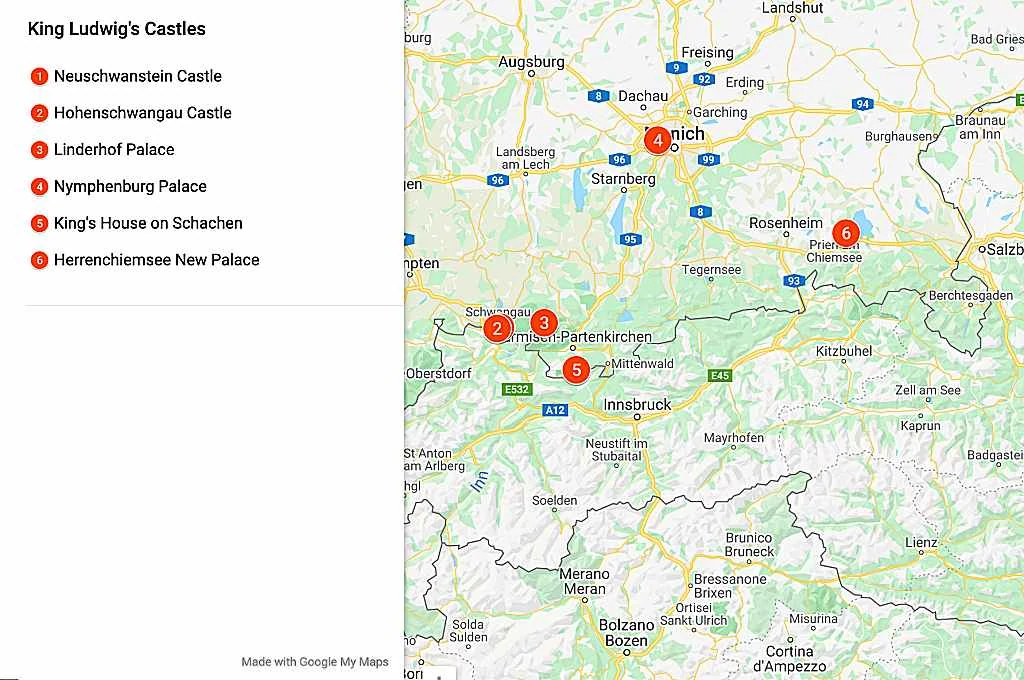
Castles of Mad King Ludwig to Visit
1. Neuschwanstein Castle
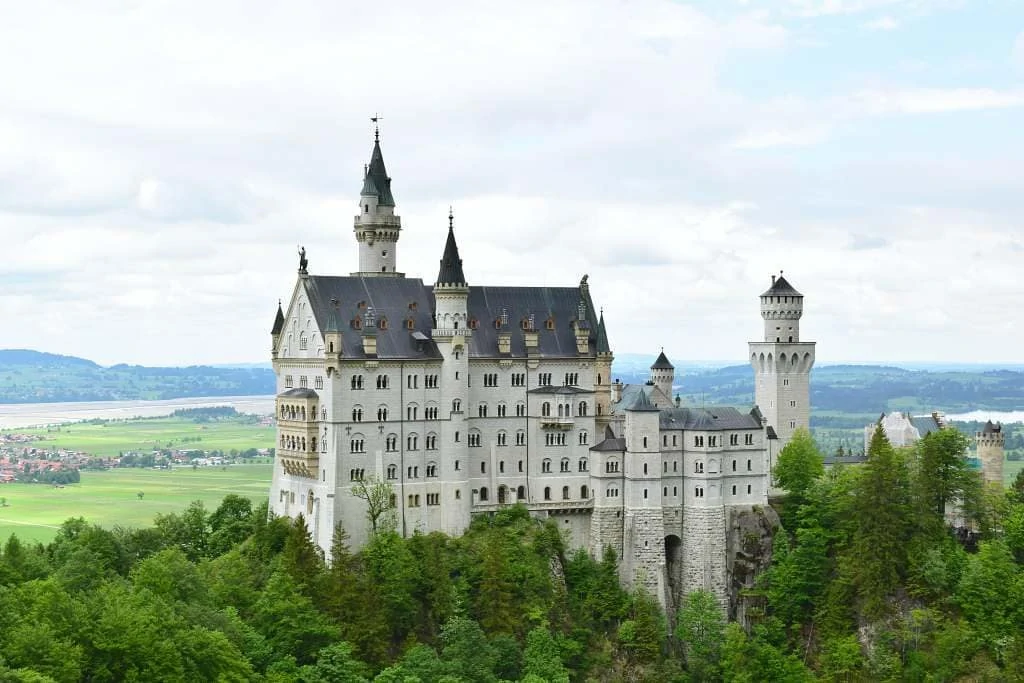
The most iconic of all King Ludwig’s Castles, this fanciful cliff-top refuge was a true masterpiece of architectural design and went on to inspire Walt Disney’s Cinderella castle.
The foundation stone of Ludwig’s dream escape was laid on 5th September 1869, with the Gateway Building completed in June 1872. Ludwig made the upper floor habitable so that he could keep a close eye on construction; however, he did not live to see his masterpiece completed
2. Hohenschwangau Castle
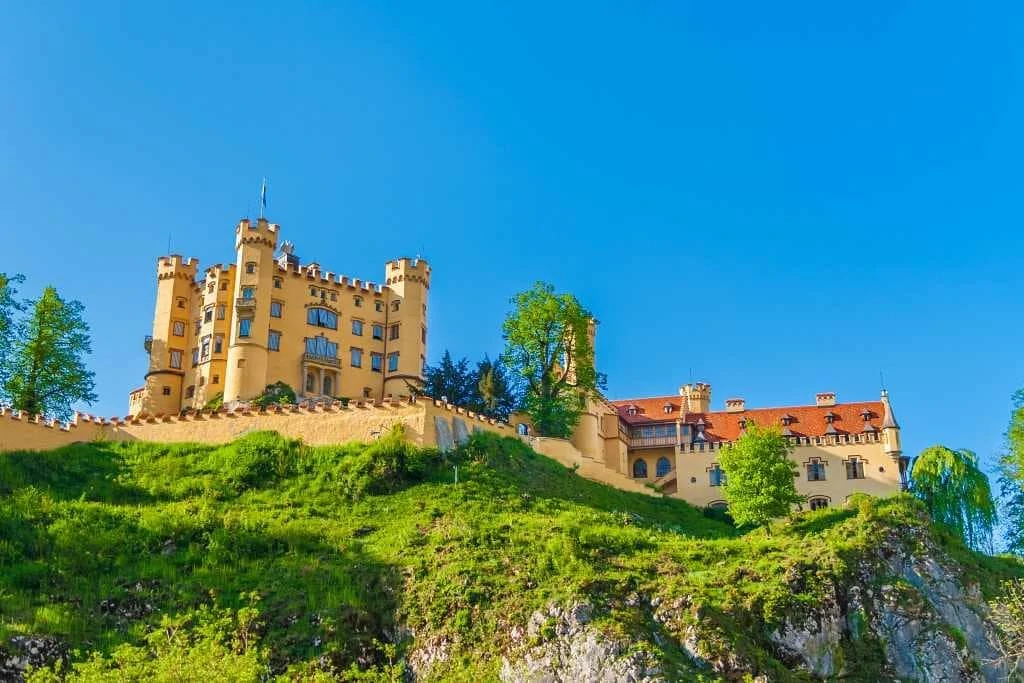
Ludwig’s childhood home, Hohenschwangau Castle, was originally built as a fortress in the 12th century but fell into ruin between the 16th-19th centuries until Ludwig’s father took a liking to the ruin and rebuilt it in the Gothic style in the 1830s.
Today, visitors can see how it would have looked in 1836, the walls decorated with the exotic myths so iconic to 19th-century Romanticism which Ludwig grew up with.
3. Linderhof Palace
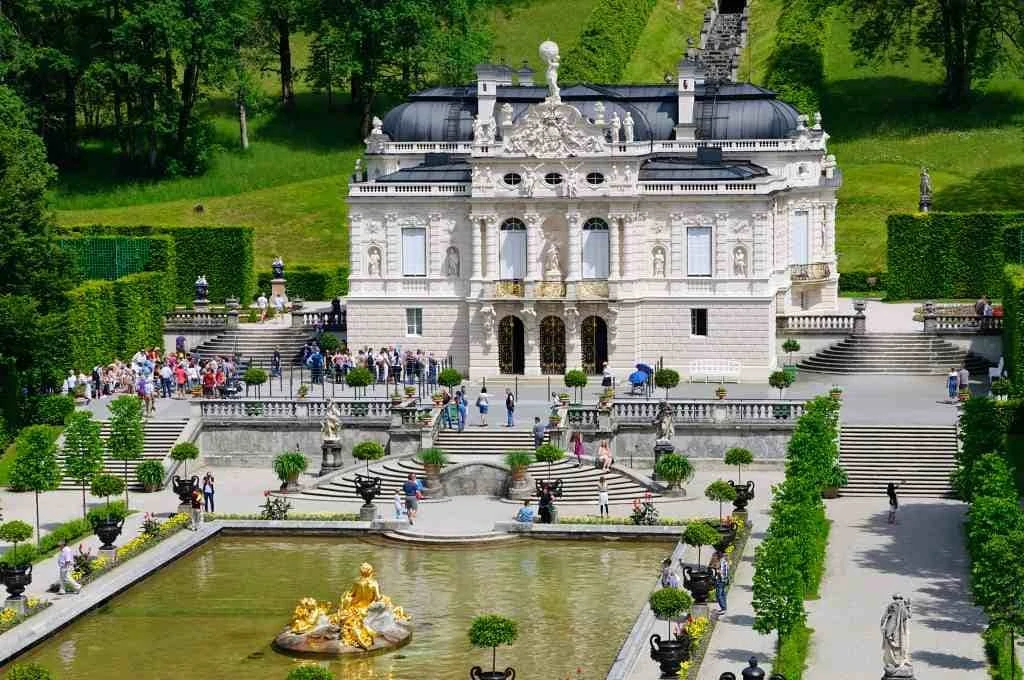
Located deep within the wooded countryside, Linderhof was the smallest of the 3 castles/palaces built by King Ludwig and the only one that he got to see finished.
Spending most of the last 8 years of his life here, Ludwig purposefully created a tiny 10-room private refuge away from the world, so much so that even the dining room table only had enough space for 1 person to eat and was constructed so that the presettable rose from the kitchen below directly into the dining room ensuring he did not have to see or interact with servants at mealtimes.
The most notable design feature of Linderhof is the unique grotto which acted as a private theatre for the King to enjoy Wagnerian operas in solitude amongst a backdrop of fake stalactites, a waterfall, and an artificial lake complete with a wave machine, and a swan boat.
4. Nymphenburg Palace
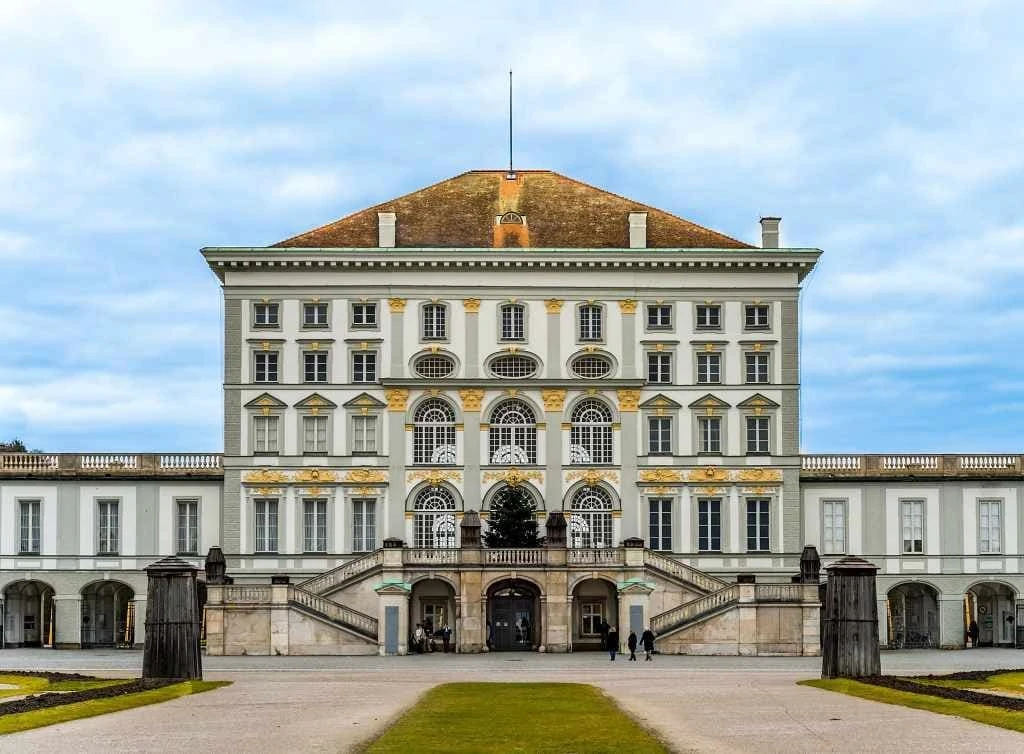
A favorite residence of the Bavarian Royal Family, this is where Ludwig’s story begins, the future King being born here on 25th August 1845.
The Baroque-style palace is located in Munich’s western district, with tours available so that visitors can see the North and South pavilions and wings of the palace, including the Queen’s Bedroom with its mahogany bed where Ludwig was born.
5. King’s House on Schachen
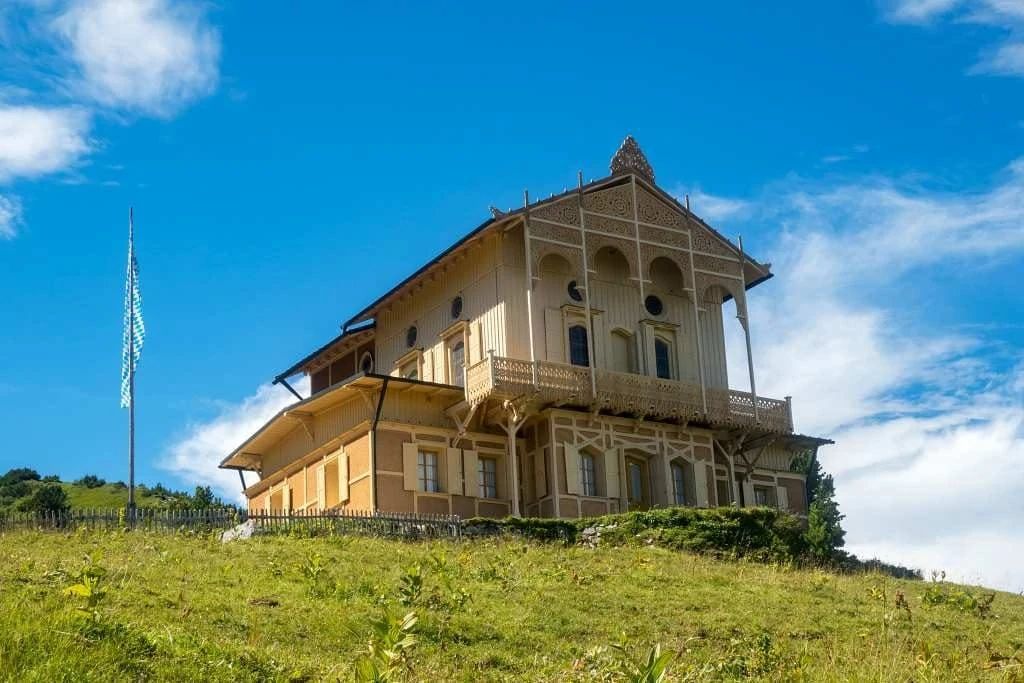
Ludwig also ordered the construction of his Schachen Alp mountain retreat in 1869. Located at an altitude of 1,866 meters and built so as to make the most of the stunning vistas of the Bavarian Alps, the small honey-colored villa was built in the style of a country house but, unlike his other buildings, was not overly lavish in its design.
Visitors who make the 4 – hour hike up to the King’s House on Schachen today are often surprised by the simplicity of the modest bed chamber with its oak furniture, but upon walking up the spiral staircase, Ludwig’s love of the finest shines through once more with the creation of the oriental styled Turkish Hall complete with water fountain, gilded walls, golden chandelier, and peacock feathers, this being the place where Ludwig would go to celebrate his birthdays and name days.
6. Herrenchiemsee Palace

The eccentric King had the wish to re-create the splendor of Versailles, so construction of Herrenchiemsee Palace, located on an idyllic floating island on Chiemsee Lake, started in 1878.
Ludwig was a great admirer of King Louis XIV of France, so he built the palace as a ‘Temple of Fame’ that honored the French King. Ludwig did not live to see his vision completed as only sections along the main axis of the landscaped gardens with the fountains were completed when he died but visitors today can admire the grounds in all their glory as well as step inside the palace to see the huge staterooms including the Great Hall of Mirrors and the French-rococo style rooms of the King located in the Small Apartment.
Click here to book a day trip to Herrenchiemsee Palace from Munich.
Whether you only visit King Ludwig’s most iconic fairytale castle or follow in the footsteps of Ludwig from birth to death, one thing is for sure, though King Ludwig II has been dead for more than 130 years, his legacy lives on through his ingenious architecture that has been enchanting young and old for centuries.
FAQ’S ABOUT KING LUDWIG’S CASTLES IN BAVARIA
The names of King Ludwig’s castles in Bavaria, Germany, are Neuschwanstein Castle, Linderhof Palace, and Herrenchiemsee Palace.
King Ludwig II of Bavaria built three castles. The famous, fairytale-like Neuschwanstein Castle, Linderhof Palace, and Herrenchiemsee Palace. Next to Neuschwanstein Castle is Hohenschwangau Castle. He did not build it, but it is the castle he grew up. Therefore Hohenschwangau Castle is connected to King Ludwig.
King Ludwig II was born at Nymphenburg Palace, grew up in Hohenschwangau Castle, and later lived in the famous Neuschwanstein Castle. Before he died, he also lived at Linderhof Palace.

great stories and pictures.